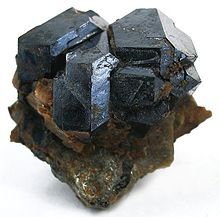Pitchblende or uraninite, consists mostly of uranium oxides. It is a pitch-black, greenish or brownish black mineral, green or brown when finely powdered; it has a smooth or conchoidal break, and is very heavy. Pitchblende is found in pegmatite dikes, sometimes, as in Cornwall, England, associated with tinstone. Other uranium minerals of similar appearance, euxenite and samarskite, are found in the same formation. Pitchblende is also found in veins of silver-cobalt-arsenic ore, as in Joachimsthal, Bohemia, and in quartz veins associated with gold, as in Colorado. Uranium ores are apt to be covered with yellow spots, or crusts of uranite or uranium ocher. Other uranium minerals of a bright yellow color are known. The early discoveries of uranium minerals in Canada were in pegmatite dikes, in areas of eruptive granite. The feldspar in the neighborhood of pitchblende is usually darkened. Sometimes a dull green stain on the feldspar or quartz indicates the presence of pitchblende. Several mines are now under development in Hastings County, Ontario, in deposits of this type.
The first productive pitchblende mine in Canada, the Eldorado Mine on Great Bear Lake, was discovered about 30 years ago and for some years was worked for its content of radium, with uranium as a by-product that was largely stock-piled on account of the limited market. This mine was the source of the uranium used in the first atomic bombs, and still is an important source of the element. Considerably larger deposits of pitchblende were discovered later at Beaverlodge north of Lake Athabaska, and now have augmented the Canadian uranium output to important dimensions. The discovery still more recently of very extensive deposits of pitchblende in conglomerate beds in the Blind River area, north of Lake Huron, has ensured Canada of a leading position in the world production of uranium. The element is now on the point of becoming an important source of power, and this will ensure an ample market for uranium far into the future.
Pitchblende has been found in the conglomerate of some of the Transvaal and Orange Free State gold mines and now is being produced in large quantities as a by-product. It is possible that uranium- bearing conglomerates of Precambrian age will be found elsewhere.
The Colorado pitchblende veins are in gneiss and mica schist. They were first worked for gold; but the gold values disappeared where the pitchblende came in. The veins are found in the neighborhood of intrusive granite and andesite. Numerous deposits of uranium have been found also in the Colorado Plateau in flat-lying bedded deposits, some of which have been worked for many years for vanadium and radium. In Germany and Austria, the pitchblende is associated with silver-cobalt ores in veins in mica schist and slate. Dolomite is a common gangue mineral; and in the neighborhood of the pitchblende, it is of brownish red color, changing to dirty gray where in contact with pitchblende.
